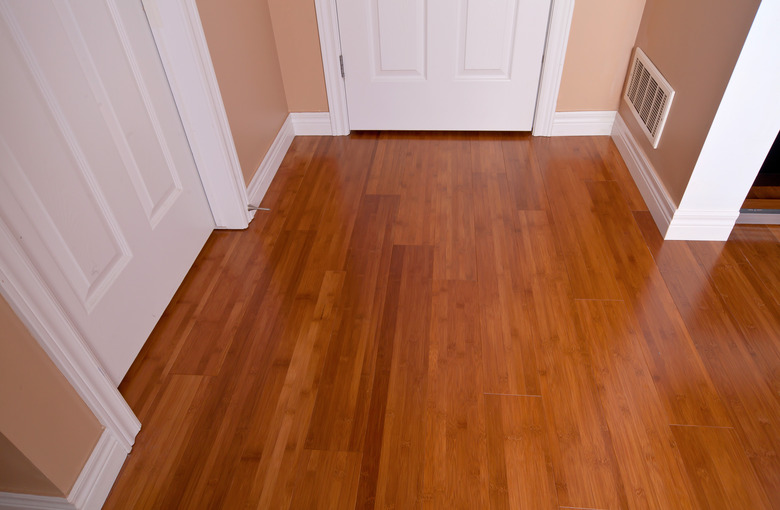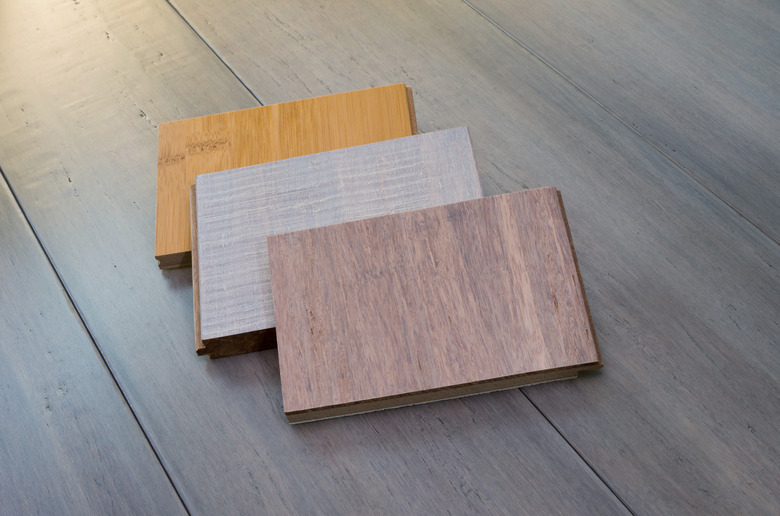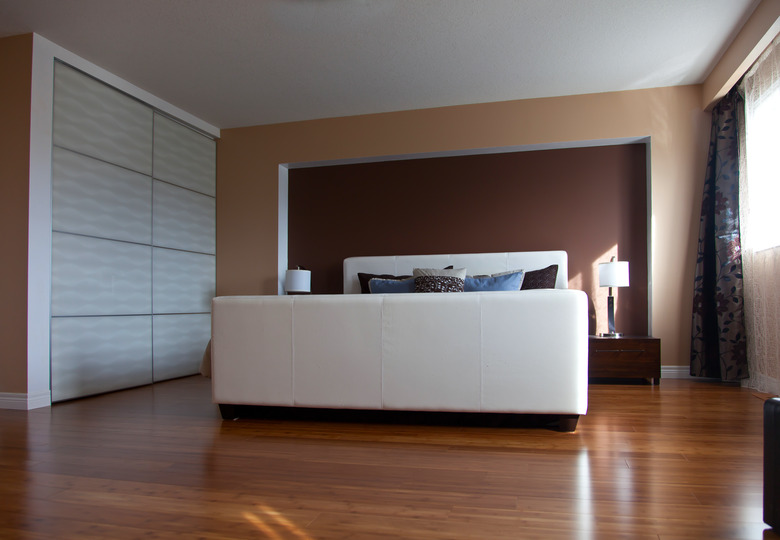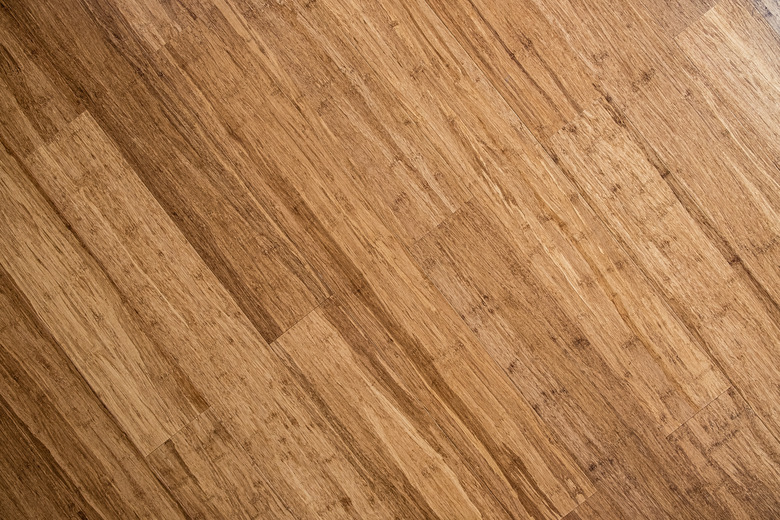How Durable Is Bamboo Flooring?
First introduced to the North American market by San Francisco-based Smith & Fong Company, bamboo flooring has graduated from its original status as a somewhat odd flooring choice to be now solidly in the mainstream. Virtually every hardwood flooring outlet offers bamboo options, and some types of bamboo flooring surpass even exotic hardwoods in durability. The key to bamboo's hardness isn't so much in the raw material itself but in the manufacturing process, and that varies.
The bamboo flooring that Smith & Fong originally imported from China is a completely different product than modern ones, such as Cali Bamboo's Fossilized Flooring, Teragren's XCORA bamboo flooring, Ambient Solid Strand bamboo or Smith & Fong's own Plyboo. The modern products incorporate strand-woven bamboo, which was also pioneered by Smith & Fong. Strand bamboo lacks the characteristic appearance of traditional horizontal or vertical bamboo, with its straight grain punctuated by the nodes present on live bamboo stalks, and looks more like a grainy wood species than it does bamboo.
Tip
Strand bamboo is one of the most durable flooring materials available, with a Janka hardness exceeding that of Brazilian walnut. Less-expensive horizontal and vertical bamboo flooring planks are about as durable as American walnut or cherry.
What Is Strand Bamboo?
What Is Strand Bamboo?
The raw material for the hardest types of bamboo flooring is Moso bamboo (Phyllostachys edulis), a species that grows primarily in China and southeast Asia. Just one of many types of bamboo, Moso grows the tallest. It's the most robust, and it comes in colors. Subspecies can have yellow stalks, green ones or striped ones that can grow as much as 3 feet per day to reach a final height of 40 to 80 feet.
The traditional way to turn bamboo into flooring is to slice the stalks into strips or cut it into pieces and glue the strips or pieces together under pressure using an adhesive that contains various concentrations of formaldehyde. The process of strand weaving is more complex and involves soaking the freshly harvested stalks to make them pliable and then slicing the stalks into very thin, fibrous strands. The strands are dipped into a low-VOC resin that still contains formaldehyde (but less of it) and are compressed into bamboo planks with a hydraulic press.
The difference in the processes is that strand-woven bamboo strands are much thinner than the strips used in the traditional process, and much of the strength of the finished product is due to the resin. As a result, strand bamboo planks are more stable and less subject to warping than traditional bamboo planks, which are often made from species that aren't as woody as Moso bamboo. Strand bamboo can be milled into wide-plank flooring, but the planks lack the characteristic bamboo appearance, and the resin gives them a plastic-like sheen.
Placing Bamboo on the Janka Scale
Placing Bamboo on the Janka Scale
The lumber industry relies on the Janka test to assess the hardness of wood species. The test consists of compressing a 1/2-inch ball into a solid plank and measuring the force required to sink it 1/2-inch deep into the material. According to this test, strand bamboo matches or exceeds the hardness of even the most durable of exotic hardwoods, but traditional vertical and horizontal bamboo are considerably softer.
Hardwood species are listed in increasing order of hardness on the Janka scale, each having a rating measured in foot-pounds of force. Cali Bamboo claims that its strand bamboo has a rating as high as 5,000 on this scale, which would put it at the very top, but a more realistic number for most brands is probably in the neighborhood of 3,000, putting them at least on par with Brazilian walnut, one of the hardest wood species. Vertical and horizontal bamboo, on the other hand, measure in the neighborhood of 1,400, which is considerably softer than strand bamboo but still harder than red oak, which is a traditional hardwood that is considered of average hardness.
One of the softest types of bamboo flooring is made from carbonized bamboo, which is darkened through a process of steaming and soaking. This process reduces the hardness to about 1,200, which is less than red oak but more than American cherry or walnut.
Is Bamboo Flooring Waterproof?
Is Bamboo Flooring Waterproof?
When it comes to bamboo flooring, moisture resistance is directly related to the quality and cost of the flooring material. The highest-quality bamboo, which is almost always strand bamboo and typically costs around $5 per square foot, is extremely water resistant to the point of being almost waterproof, owing to its high concentration of resin. The less-expensive horizontal and vertical bamboo varieties you find in discount outlets, which cost as little as $2 per square foot, are far more susceptible to moisture damage.
Manufacturers of high-quality strand bamboo flooring products claim that the products are suitable for kitchens and to a limited degree, bathrooms. No bamboo flooring manufacturer will guarantee its products against water damage in a high-use, high-humidity bathroom, but strand bamboo may be a suitable flooring choice for a guest bathroom, especially one without a shower.
Warping and fading is likely to be a problem, however, if you install less-expensive bamboo flooring in any environment in which moisture is present. The finish is less robust, so water spots are common, and because the bamboo isn't as well protected, it tends to swell when it gets wet.
Plank Format Affects Stability and Moisture Resistance
Plank Format Affects Stability and Moisture Resistance
Just as there are different types of hardwood flooring planks, there are different types of bamboo planks, ranging from solid ones with tongue-and-groove edges to snap-together engineered planks. Click-lock planks are DIY friendly when it comes to installation, and engineered planks in general are more stable than solid bamboo because they consist of laminated layers, like plywood.
The full list includes five different plank formats:
- Solid strand bamboo with a tongue and groove gets nailed to the subfloor just like solid wood hardwood planks. This format is arguable the most durable of all bamboo planks and can be installed almost anywhere that a suitable plywood subfloor exists.
- Solid strand bamboo with a click-lock profile is almost as durable as nail-down tongue-and-groove planks, but it does contract and expand with changing moisture conditions, and gaps can develop. It is recommended only for dry rooms that are less than 15 feet wide and 25 feet long.
- Engineered strand bamboo with a tongue and groove is a type of floating floor, but instead of a click-lock profile it has a tongue and groove that must be glued together. The wear layer is as hard as solid bamboo, but because the core is a different material, it may be less water resistant.
- Engineered strand bamboo with a click-lock profile is as easy to install as solid bamboo flooring with the same profile. The laminated core gives it more stability than the solid variety, and you can install it in a moderately humid room that is up to 25 feet across and 45 feet long.
- Conventional bamboo planks have a tongue and groove and get nailed to the subfloor. There is no limit to the length and width of the room in which you can install them, but they are softer and suffer impact and moisture damage more easily than strand bamboo.
Some Common Myths About Bamboo Flooring
Some Common Myths About Bamboo Flooring
Because it's a grass, most people think of bamboo as being softer than most hardwoods, but the opposite is true. This is just one of the common misconceptions that people have about this versatile, abundant material. There are others:
- Bamboo expands and contracts more than wood: In fact, being a naturally woody material, bamboo behaves almost exactly like wood. It does expand and contract, but it requires no more moisture precautions than conventional hardwood.
- Limited color options are available: The natural color of bamboo is anywhere from creamy blonde to golden brown, but those aren't the only colors you can get. Prestained and finished bamboo planks are available in a wide variety of other colors.
- You can't install bamboo on a concrete subfloor: This is not true. As long as you provide a suitable moisture barrier and use the right type of flooring, you can install bamboo on any subfloor material, including concrete.
- You can't refinish bamboo: Although sanding off the factory finish may take time, you can refinish most bamboo planks twice or more, even engineered ones, depending on the thickness of the wear layer. Sanding and refinishing isn't recommended if the top layer is less than 2-millimeters thick.
Because it's made from a fast-growing grass that is quickly replenished, bamboo flooring is clearly an eco-friendly material, but the fact that it has to be shipped from other parts of the world increases its carbon footprint, leading some to claim that it isn't as green a product as most people think. However, considering that all hardwood products manufactured overseas have to be shipped, bamboo is definitely one of the greener flooring options, especially considering that some manufacturers make efforts to control emissions and treat wastewater before releasing it.
Refinishing Bamboo Flooring
Refinishing Bamboo Flooring
Virtually all types of bamboo flooring, even strand bamboo planks, come prefinished, and the baked-on factory finish only adds to the durability of the material. When the time comes to refinish the floor, sanding off the finish takes heavy-duty equipment and expertise beyond that of most homeowners. If there's a job for which you should hire a pro, this is it.
The best candidates for staining are horizontal and vertical bamboo planks because strand bamboo is too hard and nonabsorbent to absorb the stain. You can, however, change the color of strand bamboo flooring by applying a dye, which consists of smaller, more deeply penetrating particles than a stain, or you can tint the finish coat. Staining is the most DIY friendly of these options, but if you hired a pro to do the sanding, it's best to let the pro also do the color change and apply the new finish.
If you have engineered flooring, the feasibility of sanding and refinishing depends on the thickness of the top layer, and that's something you can check by examining the cross-section of a board in a doorway. The good news is that the layer can be thinner than a comparable hardwood-faced board because strand bamboo is so hard that the sander won't wear it down very fast. The even better news is that with proper care, your strand bamboo floor shouldn't need refinishing for a very long time.
Even Durable Flooring Needs Maintenance
Even Durable Flooring Needs Maintenance
The hardest bamboo flooring comes with multiple coats of finish — the actual number on Fossilized Flooring is 10, according to the literature — so there isn't much you can do to damage it, and maintenance is a breeze. Just vacuum periodically, wipe spills as soon as they occur and avoid dragging heavy furniture across the floor.
Less-expensive horizontal and vertical bamboo isn't quite as forgiving, coming with fewer coats of finish and being a softer material to begin with. The finish degrades after several years, making water spotting and other surface water damage more likely, so you should avoid wet mopping, and it's even more important to wipe up spills quickly. It's equally important to vacuum often with a soft attachment to pick up dirt particles that can get ground underfoot and scratch the finish, which isn't as durable as the finish on quality bamboo flooring.
References
- Cali Bamboo: What Makes Fossilized Flooring So Hard?
- Teragren: Teragren Flooring
- Plyboo Direct: PlybooStrand Flooring
- Ambient Bamboo Floors: 3 Reasons Why Moso Bamboo Is The Better Flooring Choice
- Ambient Bamboo Floors: Bamboo Flooring Options & Samples from Ambient
- Lumber Liquidators: Hardwood and Bamboo Janka Ratings
- Cali Bamboo: Top 10 Bamboo Flooring Myths



